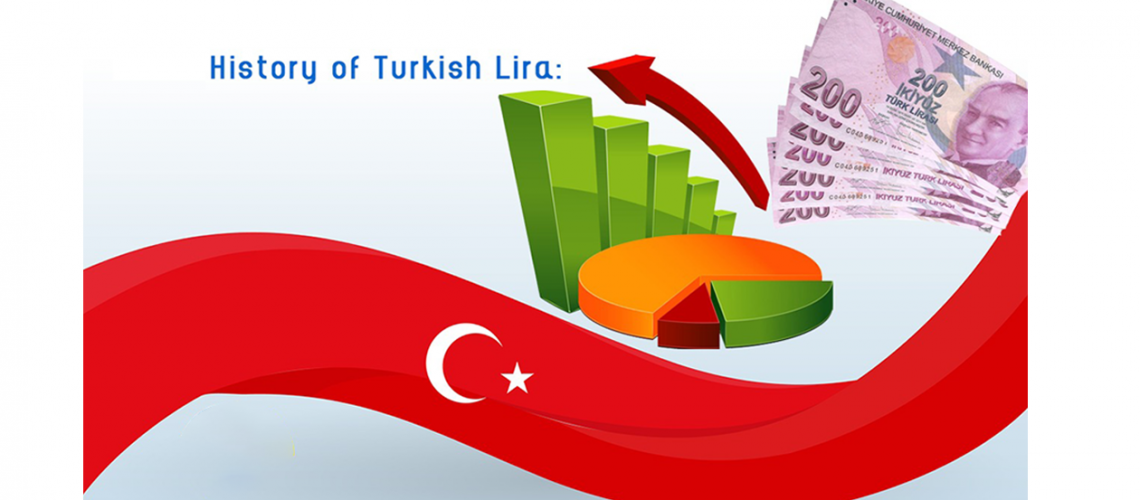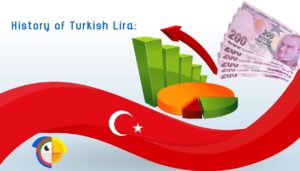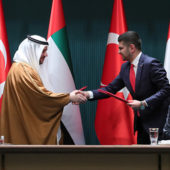In the new economy, information, education, and motivation are everything.
Being familiar with Turkish Lira is a must, either you’re planning a trip to Turkey or planning to invest and set up your business in Turkey. It was formerly known as TRL and is now known as TRY – Symbol; This is your one-stop reference on Turkey’s currency. It is covering everything from the history of the Turkish Lira to how to use it now. Let’s discover History of Turkish Lira together.
1 – History of Turkish Lira:
Turkey has a long and stormy history, and its currency is no exception. Since its introduction as Turkey’s currency, the Lira has undergone several adjustments.
This type of currency was available as the Ottoman Lira in 1844. It was available as a replacement for the kurus. Also, it was the basic unit of money in the Ottoman Empire. Lira was renamed Turkish Lira in 1923 after the Ottoman Empire fell apart and the Republic of Turkey was formed.
The Turkish Lira was a very stable currency. But History of Turkish Lira shows that in the 1970s when inflation started to rapidly depreciate Lira. It got so devalued that Turkey was obliged to abandon the old Lira in favor of a new one. The chart below shows the annual average value of the Lira in the years leading up to 2005.
- 1960s – US Dollar $1 = T₤9
- 1970 – US Dollar $1 = T₤11.30.
- 1975 – US Dollar $1 = T₤14.40.
- 1980 – US Dollar $1 = T₤80.
- 1985 – US Dollar $1 = T₤500.
- 1990 – US Dollar $1 = T₤2,500.
- 1995 – US Dollar $1 = T₤43,000.
- 2000 – US Dollar $1 = T₤620,000.
- 2001 – US Dollar $1 = T₤1,250,000.
- 2005 – US Dollar $1 = T₤1,350,000.
2 – Ottoman Lira:
Similar to the currencies of Europe and the Middle East, the Turkish lira is derived from the libra. It was an ancient Roman metric equal to the Troy pound of silver. The use of the Roman libra as a currency expanded it across Europe and the Near East, where it remained in use until medieval times. In addition to the Turkish lira, the French livre (until 1794) and Italian lire (until 2002) are current successors to historical money. Its short name of the “lb” when measuring weight, as a translated version of the Roman libra.
In 1844, the Ottoman lira was available as the primary unit of money, with the previous currency, kuruş, continuing as an 1100 subdivision. The Ottoman lira was still in use until the end of 1927.
- The First Turkish Lira (1923–2005):
The History of Turkish Lira explains that several historical banknotes feature the smet nönü image on their obverses. Following World War II, the Democrat Party repealed this alteration in the official gazette on 12 January 1926.
There was a currency peg in place since 1946, lasting until 1960, when it was devaluing up to T9 = US$1. A series of hard and soft pegs to the US dollar was available as the value of the Turkish lira plummeted in 1970.
The Turkish lira was named the world’s least valued currency by the Guinness Book of Records in 1995 and 1996, then again from 1999 through 2004. An original gold lira coin, before the 2005 revaluation, could be purchased for T154,400,000.
- Turkish Lira II (2005–Present):
As of December 2003, a bill was passed by the Turkish Grand National Assembly. The Turkish lira had six zeros removed from it for redenomination. A new currency was also available as part of the redenomination. The new currency went into circulation on January 1, 2005. After replacing the Turkish Lira, it will be used across all of Turkey. In the chorus, the History of Turkish Lira shows that the government issued two new banknotes in values of 50 and 100.
Yeni Türk lira (“New Turkish lira”) was the official name of the second Turkish lira between January 2005 and December 2008. Yeni, which means “new” in Turkish, is the letter “Y” in the currency code. Its short name the “YTL” and split into 100 new kuruş (yeni kuruş). TL, abbreviated as “TL”, became the official name of the second Turkish lira in January 2009. The face of Mustafa Kemal Atatürk appears on all obverse sides of modern banknotes.
There used to be no difference between the reverse sides of all current coins prior to 2016. Coins of the one-lira denomination were, however, available in 2016. It was ideal to commemorate “martyrs and veterans” of the 2016 coup d’état attempt in Turkey. Some of these cards have a design on the reverse side of a Turkish flag that the people can hold hands on. Nevertheless, others are stylized Turkish flags topped with five-pointed stars.
To avoid fraud, the new banknotes have various sizes. The fundamental difference between this new series and others is that each denomination portrays a renowned Turkish individual rather than the geographical or architectural characteristics of Turkey.
3 – Today’s Lira:
The E-9 banknotes were available on January 1, 2009, for the first time. So, the previous E-8 banknotes were no longer valid on December 31, 2009.
Until 2015, it was not possible to convert the old Turkish Lira into the United States dollar or any other currency. However, some internet businesses or collectors were willing to pay you the current rate. It was simply six zeros dropped, and 1 million is equal to 1 lira now.
There have been various distinct kinds of Lira developed in the previous 20 years. It’s critical to distinguish between them so you don’t get obsolete cash with no value.
The high number on the money is an obvious method to identify ancient notes (pre-2005). Although the New TRY (E-8) banknotes are no longer legitimate or extensively circulated, it is nevertheless important to be aware of them and refuse to accept them. These banknotes include multiple pictures of Mustafa Kemal Ataturk (the Republic of Turkey’s founder and first president) as well as photos of other historic and notable structures and locales around Turkey.
There is still a portrait of Mustafa Kemal Ataturk on the front of the Turkish Lira, aka the only banknote you should accept. The reverse, however, depicts many historical figures associated with Turkey.
A few additional security features are also available in the new denominations of banknotes. The banknotes differ in size, have multiple images of Ataturk, have holograms, and have a security thread containing TL and the currency’s value. When taking banknotes, be sure to look for one or more of these security measures, particularly for bigger values.
4 – Traveling in Turkey? Here Are Some Currency Tips:
Now that you’ve learned about the TRY’s history, it’s time to learn how to make the most of the Lira when visiting Turkey.
ATMs are widely available in Turkey, as they are everywhere else, and are the most convenient method to get cash. However, it is not necessarily the most cost-effective or secure option to get Turkish Liras.
Because bank fraud is a concern in Turkey, as it is anywhere, it is essential to notify your bank that you will be traveling there. Otherwise, when you try to withdraw cash from an ATM. You may face rejection and your card may never work again. This is available to protect you, but it may truly ruin your holiday.
One of the greatest methods to get authentic TRY banknotes is to use a currency exchange. The best exchange rates are generally available at currency exchange offices in local market areas. Airports nearly often have the worst conversion rates, so save your money until you are in town.
History of Turkish Lira clarifies that you’re in luck if you don’t want to stroll about with a wad of cash. Because most establishments in Turkey accept credit cards, your plastic may become your closest friend. As with your bank card, let your credit card provider know you’ll be traveling so they don’t cancel your card when they detect charges in Turkey.
What Else Should You Know About Money in Turkey?
It’s always a good idea to stay current on the exchange rate. So, you know how much you’re paying and if you’re receiving a fair deal at an exchange office. At the moment, one US dollar is worth around 12,63 Turkish lira, but this might change fast.
To secure your purchases, if you buy a tour or transportation online with a credit card, make sure you have the card with you for them to confirm.
History of Turkish Lira shows that tipping is traditional in Turkey for porters, housekeepers, and restaurant servers. However, most credit card slips do not contain a line for a tip. So, you should carry some cash to express your gratitude.
Bring Lira and small amounts if feasible for buying in local marketplaces. While the local merchants may have some change, it is more convenient for both you and them if you can pay in smaller amounts.
5 – The Symbol For Lira Currency:
The History of Turkish Lira shows that it was first available as the acronym T. It is because the Ottoman Lira sign had been inherited from the Ottoman lira and the T was added. While it is true that the acronym TL is more commonly in use in the Turkish language, it may not the exact case for all typewriters.
Designed by the Central Bank of the Republic of Turkey in 2012, the Turkish lira’s current currency symbol is a crown. The new sign was available in a nationwide competition. Tülay Lale designed the new emblem. It consists of a letter ‘L’ shaped like a half anchor and an inset double-striped letter ‘T’ oriented at 20 degrees.
Tülay Lale’s design was available as the winner of a national competition. Shortlisted from a total of 8,362 submissions, it was available as the winner by the Central Bank’s board of directors. The sign had the shape of the initial letter of the Turkish monetary unit L, with a half anchor and a double stroke.
On March 1, 2012, Prime Minister Recep Tayyip Erdogan introduced the new emblem. Erdogan described the design at the time of its debut. He says that the anchor form intends to express that the currency is a safe harbor,’ while the upward-facing lines indicate its increasing reputation. The Turkish lira has suffered from severe inflation and currency devaluation during the current 2018–2021 Turkish currency and debt crisis. But the History of Turkish Lira shows that this currency will improve in the future.








